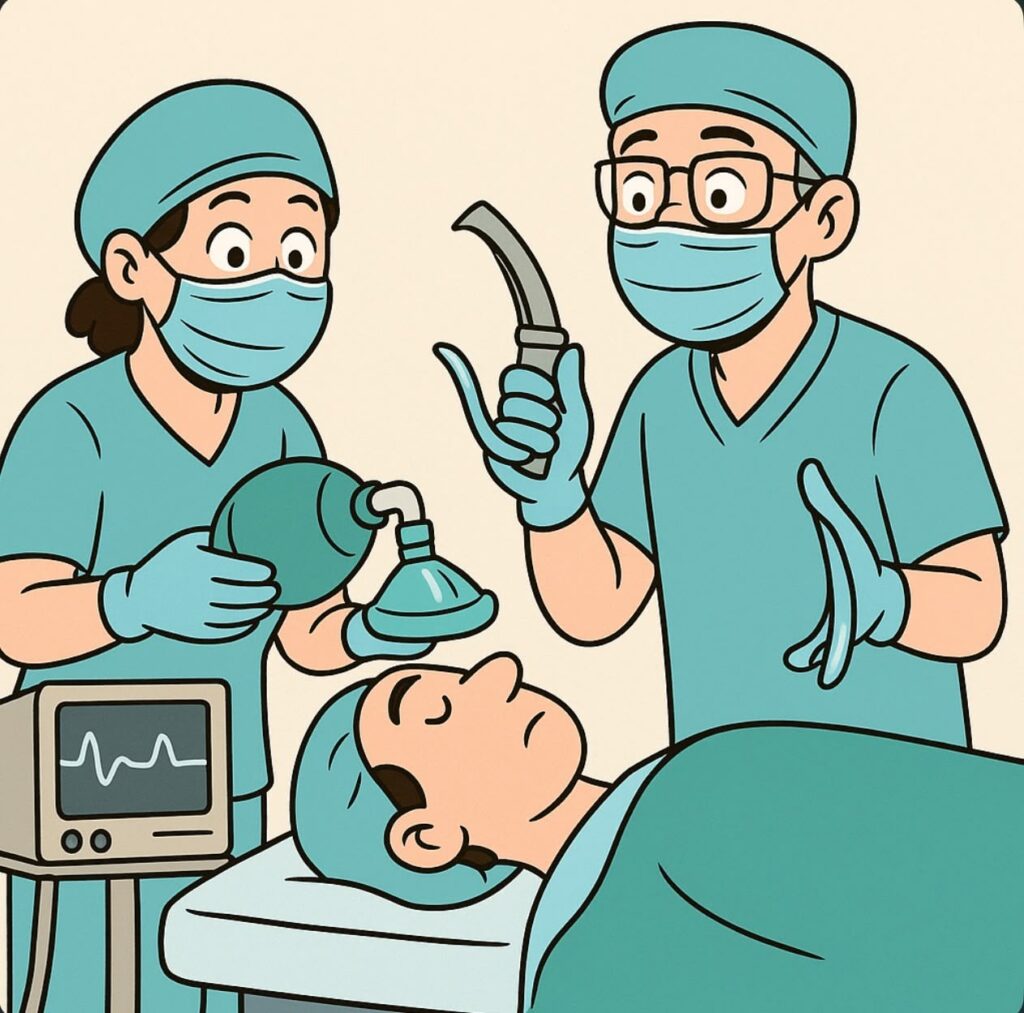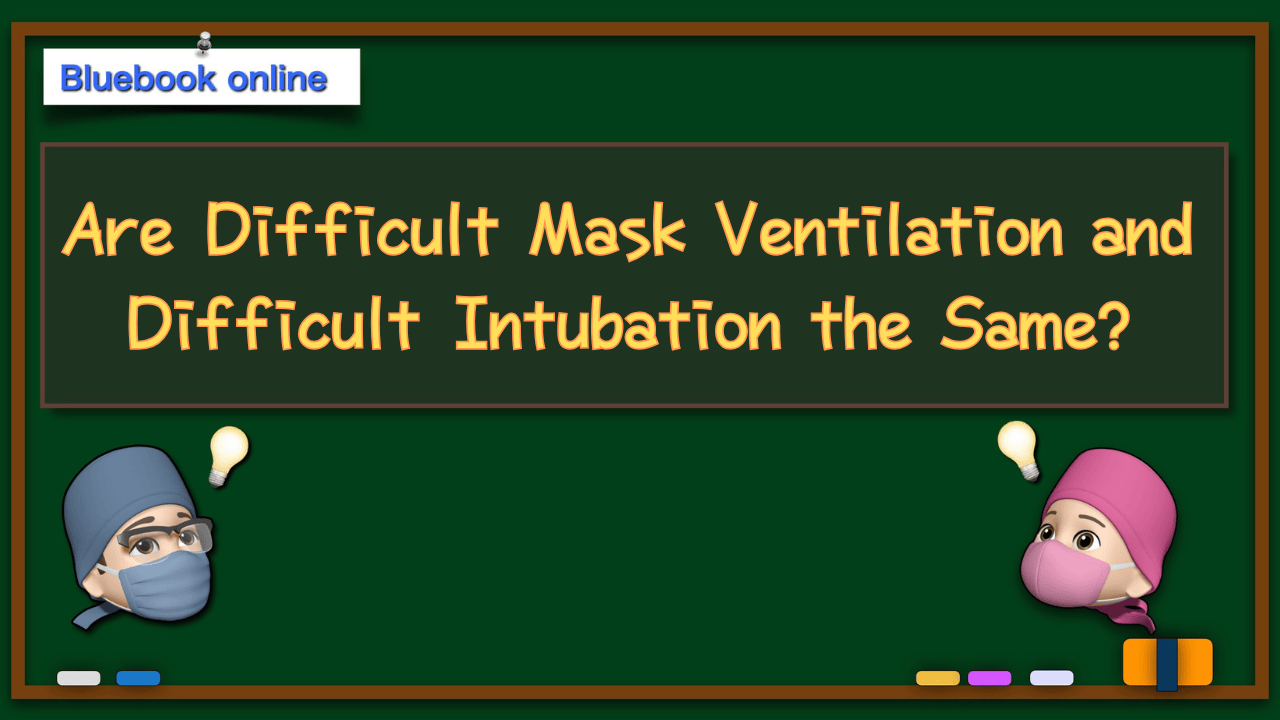👉👉 🇺🇸 All Posts 🇬🇧 / 🇯🇵 記事一覧 🇯🇵 👈👈
♦️ Introduction

In the operating room, terms like “difficult airway cart” and “history of difficult intubation” are often mentioned. The WHO Surgical Safety Checklist also requires anesthesiologists to evaluate the risk of a difficult airway before induction.
♦️ What Is a Difficult Airway?
A “difficult airway” refers to a situation where trained providers encounter difficulty in establishing and maintaining airway patency, whether by mask ventilation, intubation, or other techniques.
Normally, when awake or even during natural sleep, the airway remains patent. Under anesthesia, however, sedatives and muscle relaxants can cause the tongue base to fall back, obstructing airflow.
Simple maneuvers such as chin lift, jaw thrust, or tracheal intubation usually restore patency—but in certain patients, these steps remain difficult even for experienced anesthesiologists.
👉 The concept of a difficult airway is broadly divided into Difficult Mask Ventilation (DMV) and Difficult Intubation (DI).
🔷 DMV vs DI: Not the Same Thing
- Difficult Mask Ventilation (DMV): Inability to maintain adequate ventilation with a bag-mask device.
- Difficult Intubation (DI): Inability to visualize the glottis or insert a tracheal tube despite attempts.
A patient may have DMV but easy intubation, or easy mask ventilation but very difficult intubation. They are related but not identical concepts.
For many trainees, the surprising lesson is how challenging proper mask ventilation can be. Bag-valve-mask devices can give a false sense of ventilation because air can be pushed regardless of airway obstruction. In contrast, anesthesia ventilators or breathing circuits give clearer feedback (stiff bag, collapse, or resistance).
🔷 If You Can Ventilate, You Can Wait
If mask ventilation is possible, there is no need to panic. One can stop induction, call for senior help, or prepare alternative intubation devices.
👉 The truly dangerous scenario is CVCI (cannot ventilate, cannot intubate). This is why repeated, blind intubation attempts are strongly discouraged.
♦️ Preoperative Airway Evaluation (Updated per ASA 2022)
Before general anesthesia or airway management, whenever feasible, perform a thorough airway risk assessment. The ASA 2022 Guidelines introduced a structured decision-tree to help determine whether to proceed with awake vs asleep intubation.
🔷 Awake intubation should be considered if any of the following are anticipated:
- Difficult ventilation: Mask or supraglottic airway ventilation may not be possible.
- Aspiration risk: Full stomach, delayed gastric emptying, reflux, pregnancy, etc.
- Rapid desaturation: Poor tolerance of apnea due to obesity, pulmonary disease, or reduced oxygen reserve.
- Emergency invasive airway difficulty: Anticipated difficulty with cricothyroidotomy or surgical airway due to prior surgery, radiation, or anatomy.
🔷 Additional considerations emphasized by ASA 2022:
- Backup personnel and equipment must be available before induction.
- Limit attempts at laryngoscopy, supraglottic airway, or intubation.
- Maintain situational awareness: monitor elapsed time and oxygen saturation, and avoid persisting with ineffective techniques.
- Whenever possible, use oxygenation strategies throughout (e.g., nasal cannula, high-flow oxygen, head-up position).
🔷 Other Common Risk Factors (from ASA & DAS guidelines)
- High Mallampati class (III/IV)
- Short thyromental distance or limited jaw protrusion
- Prominent teeth, dentures, dental abnormalities
- Obesity (BMI ≥30 kg/m²)
- Male sex
- Thick neck or beard
- Age >40–50 years
- Obstructive sleep apnea
- Cervical spine immobility or instability
- Anatomical changes due to burns, trauma, or tumors
👉 Multiple factors combined significantly increase the likelihood of airway difficulty.
📝 Summary
- DMV and DI are different entities—they do not always overlap.
- Mask ventilation buys time; intubation may fail, but oxygenation must not.
- CVCI is the most critical scenario and must be anticipated.
- Preoperative airway assessment is essential, using recognized risk factors.
- Prepare alternative strategies (supraglottic devices, video laryngoscopy, surgical airway) if risk is high.
📚 References & Links
- Apfelbaum JL, Hagberg CA, Caplan RA, et al. Practice guidelines for management of the difficult airway: An updated report by the ASA Task Force on Management of the Difficult Airway. Anesthesiology. 2013;118(2):251-270.
- Frerk C, Mitchell VS, McNarry AF, et al. Difficult Airway Society 2015 guidelines for management of unanticipated difficult intubation in adults. BJA. 2015;115(6):827-848.
- Higuchi H, et al. Airway Management Guidelines 2014 (Japanese Society of Anesthesiologists). Supplementary reference (English abstract available at JSA official site).

コメントを投稿するにはログインしてください。